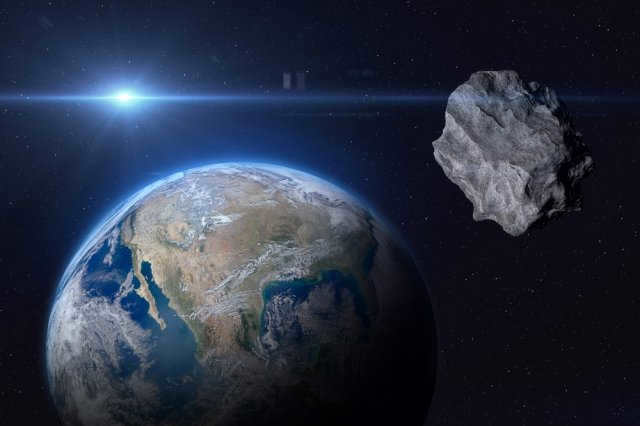
A new asteroid flew by the Earth on January 27. With the name 2023 BU, this object had the same size as a truck and passed just 3.6 thousand kilometers above the planet’s surface. This distance is 10 times closer than the orbits of geostationary satellites. However, what’s even more concerning is that it was only observed a few days before its close approach. Interestingly, it was discovered by Russian astronomer Gennady Borisov.
And even though a “pebble” like that, when it enters the thick layers of the atmosphere, would still be incinerated, it doesn’t make it any less concerning. The mere fact that an unknown asteroid flew so close to us is alarming and leaves us questioning: how well are we prepared for defending against such threats? Have the scientists, who have managed to explore the depths of the universe, really accounted for and cataloged all the small celestial bodies in our solar system?

A conversation with Leonid Elenin, an astronomer and writer, who is also a researcher at the Keldysh Institute of Applied Mathematics of the Russian Academy of Sciences, was conducted by aif.ru. He has made significant contributions to the field, having discovered 6 comets and 125 asteroids, with around 1.5 thousand more awaiting confirmation.
– Leonid, how many asteroids are there in the solar system? And what percentage of the total number are known to scientists?
– Scientists have identified over a million asteroids in the solar system. However, our focus is on the near-Earth asteroids, also known as Earth-approaching asteroids. There are over 30,000 of these asteroids. Among them, more than 1,000 are substantial objects with a diameter exceeding one kilometer. Some individuals may argue that nearly all of these large asteroids have been discovered, but a more plausible estimate suggests that scientists have identified around 95% of them. This is supported by the ongoing discoveries in this field. For instance, just last autumn, a new potentially hazardous asteroid with a diameter greater than one kilometer was discovered.
What is an object larger than one kilometer? It is a continental disaster, releasing tens of thousands of megatons of energy. Just to remind you, the object that exploded over Podkamennaya Tunguska was only 80 meters in size, but it had enough power to destroy 2,000 square kilometers of taiga.
A continental catastrophe doesn’t mean that only one continent will suffer while people on the other side of the world enjoy lavender lattes and watch TV. Everyone will be affected! Trillions of tons of dust and ash will be thrown into the sky, causing massive forest fires. The sun will be blocked for several years, leading to crop failures and widespread famine. The consequences will be devastating.
So, while we have a good understanding of kilometer-sized objects, our knowledge about smaller bodies is significantly limited. We have identified only a small percentage of asteroids with diameters of hundreds of meters, and our knowledge about those smaller than 100 meters is nearly non-existent. However, it is important to note that these smaller asteroids make up the majority in terms of quantity.
– Given this situation, it is not surprising that asteroid 2023 BU was only detected a few days before its approach, considering its size of just 8 meters.
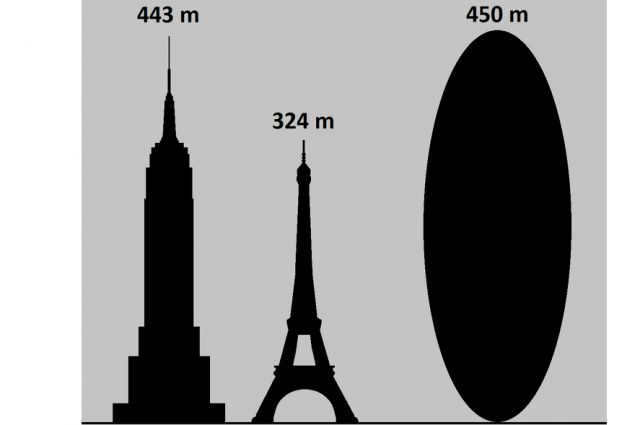
– It is a well-known fact that approximately half of small asteroids are detected after they have already passed by Earth. It is quite common for objects measuring tens of meters in size to be noticed just a few days before their close approach. Regrettably, this is the current extent of humanity’s capabilities. Despite significant advancements over the past three decades and the continuous discovery of new near-Earth asteroids by astronomers, we are still limited in our ability to detect and track these celestial bodies in advance.
— How is this phenomenon possible? I suppose it is improbable that astronomers now physically sit inside the “glass” of the telescope, as they did in the past, and gaze at the night sky with their own eyes?
– Nowadays, everything is done by a computer and, if necessary, it notifies the observer. The entire sky is divided into sectors, and the telescope captures images of the selected regions, taking 3-4 shots with a 15-20 minute interval. This allows for the observation of motion. If the object appears stationary in each frame, it is identified as a star, which is not of interest to us. On the other hand, if it exhibits movement, it is recognized as a small celestial body. The computer then records the coordinates of each point, constructs an initial orbit, and attempts to determine whether this object is already listed in the catalog or not.
If the object is unidentified, it alerts a human observer. And the observer then verifies: is it genuinely a celestial body or possibly a false positive, an error? Currently, only the human eye can identify it. And if the object is genuine, the data regarding it is placed on the verification page, where it is accessible to all observatories worldwide. From there, it can be “picked up”: to observe it, refine its orbit, and validate its existence. It is believed that without such independent validation, if I am the only one to have captured images of this asteroid, it will not be recognized.
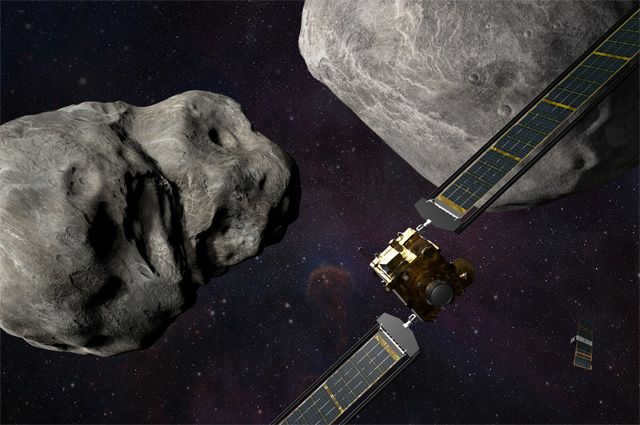
Indeed, there is a distinction: Americans possess the ability to accomplish this task. In the event that their observatory detects an object, they will be recognized for it and assigned a temporary designation. However, this is not the case for others.
– Oh, dear! So politics has infiltrated the field of astronomy as well?
– The reality is that Americans have more expertise in these observations, their instruments are finely tuned, and they have numerous skilled professionals working there. They utilize telescopes that provide highly accurate measurements. Overall, the international astronomical community places trust in the outcomes of their observations, hence the existence of such a preference.
In truth, the Americans make the majority of discoveries of such objects. 98% of the small celestial bodies in the solar system are detected by them. They have the ability to locate dozens of them each night.
– What about us? Our compatriot Borisov spotted the same asteroid 2023 BU. Is this a significant event for our scientific community?
– Yes, it is a momentous occasion for our national astronomy, almost like a holiday. Gennady Borisov was fortunate to make this remarkable discovery. Consider this: throughout history, Soviet astronomers have only identified slightly more than fifty near-Earth asteroids. And as I mentioned, there are over 30,000 of them.
– So, is there some sort of competition among astronomers?
– It’s not exactly a competition, but the desire for discovery is always present. Otherwise, why pursue a career in science?
– Are you hoping to have an asteroid named after you?
– What if it is later discovered that the asteroid poses a threat to Earth and a mission is dispatched to destroy it, reducing it to fragments?
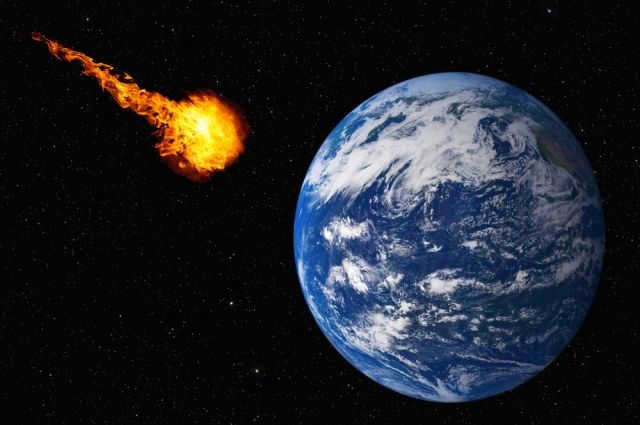
– So, what options do we have? Even worse, if they fail to send it out on time and it smashes into the Earth. Then you’ll go down in history for a very long time.
Truly an endless wellspring of peril
– Speaking of crashes. Out of the 30,000 asteroids that are approaching the Earth, how many pose a potential threat?
– Currently, there are approximately 2,300 that are known. However, there’s a clarification that needs to be made. “Potentially dangerous asteroid” is a scientific term, and it carries a different connotation than what is commonly perceived. It doesn’t mean that this object could collide with the Earth tomorrow, the day after, in a month’s time, or a year from now. It simply means that its orbit occasionally comes close to the Earth’s orbit and its size exceeds a certain threshold.
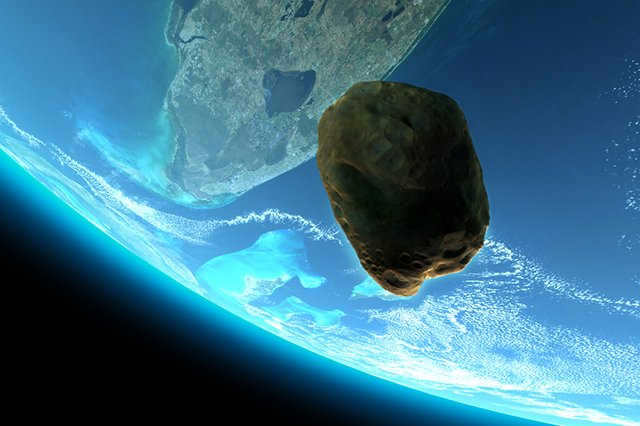
These asteroids are referred to as potentially hazardous because at some point in the distant future, perhaps thousands or even tens of thousands of years from now, their orbits could shift in such a way that they pose a potential threat to Earth. In other words, there is a chance that they could actually collide with our planet.
– So, just to clarify, there are currently no asteroids that pose a real danger to Earth?
– Out of all the known and cataloged asteroids, none of them are currently considered a significant threat. There has been a lot of discussion about a particular asteroid called Apophis. When it was first discovered in 2004, there was even a sense of panic as it was believed that a collision with this object could lead to a catastrophic event. However, subsequent observations have shown that there will be no collision in 2029 or 2036 when it comes close to Earth. Only time will tell if its orbit changes in the future.
– Take a look at what’s happening. Out of all the asteroids we are aware of, none of them pose a significant threat. We can relax a bit. However, you also mentioned that we only know a small percentage of these objects, with most of them being hundreds of meters in size. So there’s really no reason to feel completely at ease, is there? It’s like the sword of Damocles hanging over us constantly.
– Precisely. It’s possible that a classic Apollo asteroid, measuring 200 meters in diameter, could suddenly appear and unleash an explosion equivalent to several thousand megatons.
However, that is not the end of the story. There are four distinct categories that near-Earth asteroids can be placed into. The Apollos, similar to the Amur asteroids, traverse the Earth’s orbit from the outer side, while the Atons come from the inner side. Additionally, there is the Atira group, which revolves within the Earth’s orbit and only approaches us from the side facing the Sun, making them impossible to observe as they become obscured by its rays. Our knowledge about these asteroids is quite limited, with only a handful of them being identified thus far. Nevertheless, this does not indicate that they are scarce in number; rather, it is simply a matter of not being able to detect them. In fact, these asteroids can sometimes come perilously close to Earth and even collide with its surface. The Chelyabinsk meteorite is a prime example of such an event, as it originated from the direction of the Sun.
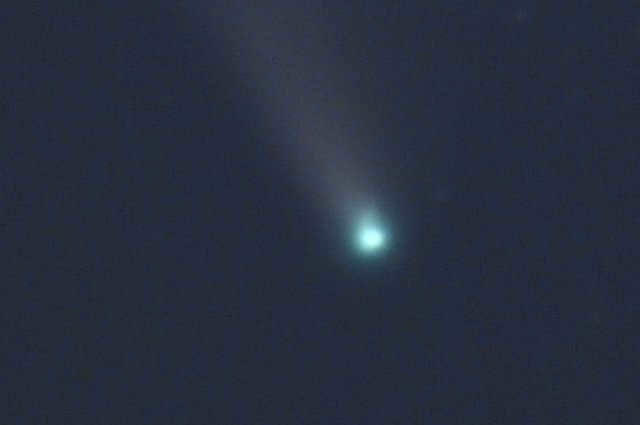

A different significant danger does not originate from asteroids, but rather from long-period comets. These comets come directly from the Oort cloud, a spherical region within our solar system that is located very far away, yet is filled with tens of trillions of ice blocks that are over a kilometer in size. It is truly an endless source of peril. Moreover, the danger is essentially unpredictable. There is a possibility for such a comet to emerge from any direction in the sky, even from the polar region, which is not frequently observed.
– What are the chances of such a comet arriving?
– It’s true that the chances are slim. The risk of being struck on the head by a brick is much higher. During the early stages of the planet’s formation, it was constantly bombarded by comets. It was a massive onslaught that eventually came to a halt.
However, in the realm of astronomy, collisions with celestial bodies are a normal occurrence. Astronomers have a saying: it’s not a matter of if it will happen, but when. Because inevitably, it will happen. At some point, all the elements will align. Recently, a scientific article was published on this subject, stating that the Earth is expected to collide with a one-kilometer diameter comet from the Oort cloud approximately every 200,000 years. In cosmic terms, this is considered quite frequent.
On February 15, the 10th anniversary of the Chelyabinsk meteorite’s fall, a continuation of the interview with Leonid Elenin can be read on aif.ru. In this interview, Elenin will discuss the lessons that scientists have learned from this event, the establishment of asteroid-comet observation protocols, and what actions to take if a collision with a celestial body becomes unavoidable.
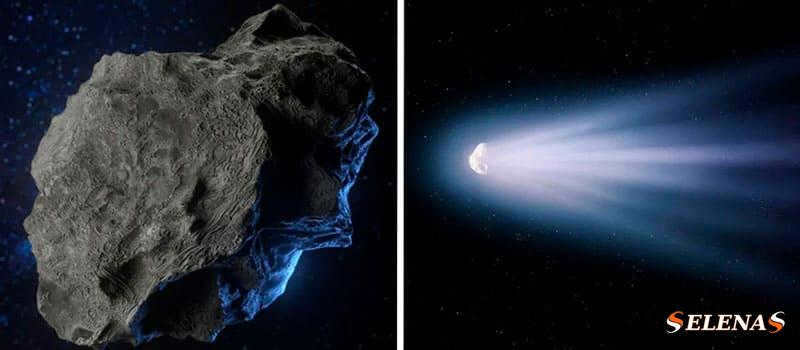
Now let’s examine the distinctions between asteroids and comets.
- Asteroids and comets originated during the formation of our solar system;
- They have distinct shapes and compositions and typically originate from different regions within the solar system;
- However, there are certain objects that blur the boundaries between the two.
About 4.5 billion years ago, the birth of the solar system gave rise to the Sun and the familiar planets we know today.
However, it also brought forth numerous smaller entities such as comets and asteroids.
Occasionally, comets may even have close encounters with planets and moons.
However, it is important to note that comets and planets are distinct entities.
What exactly are comets and where do they originate from?
To put it simply, comets are celestial bodies composed primarily of ice and dust that revolve around the Sun.
Nevertheless, their nature encompasses much more than just this basic description.
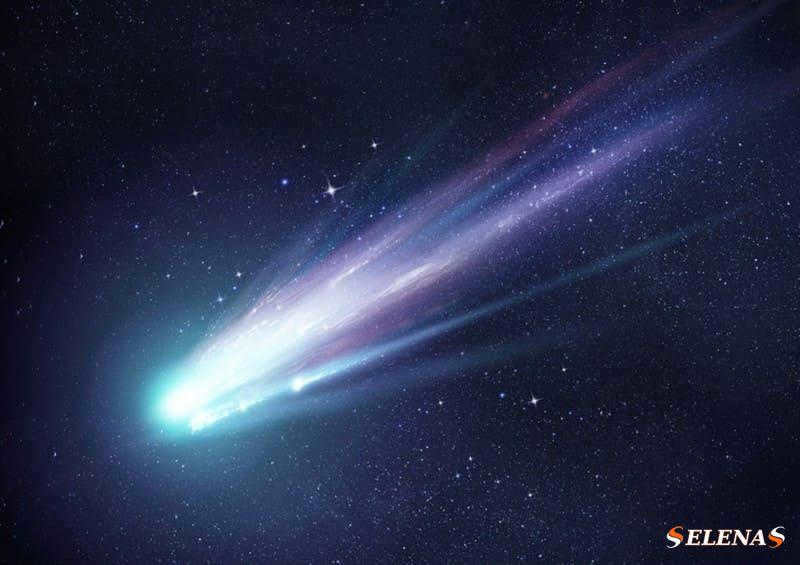

Comets have been present since the formation of our solar system approximately 4.5 billion years ago.
One of their most recognizable features is their long, flowing tails.
However, the majority of comets are located far away within our solar system.
Some can be found in the Kuiper Belt, an expansive disk composed of icy objects that exists beyond the orbit of Neptune.
It is believed that this region is the birthplace of short-period comets, which complete an orbit around the Sun in less than 200 years.
The Oort Cloud, a theoretical spherical shell encompassing the solar system at a distance of approximately 100,000 astronomical units (a.u. – about 100,000 times the distance between Earth and the Sun), is thought to be the habitat of a vast number of additional comets.
Long-period comets are named as such because of the lengthy time it takes for them to complete an orbit around the Sun.
Scientists estimate that certain long-period comets can require up to 30 million years to complete a single revolution around the Sun.
The comet with the most extended known orbital period takes more than 250,000 years to complete one orbit around the Sun!
Gravitational forces from planets or stars can dislodge comets from their original locations in the Kuiper Belt or Oort Cloud.
If the gravitational pull is strong enough, it can redirect the comet towards the Sun and the inner planets of our solar system.
This phenomenon alters the comet’s trajectory from its usual path.
Over time, if you were to observe these comets, you would notice their orbits gradually transforming into elongated ovals.
A celestial body known as a comet revolves around the Sun, gradually accelerating as it draws nearer to the Sun before changing course and heading back in its initial direction.
In certain cases, certain comets might even collide with the Sun, breaking apart into minuscule particles and disappearing forever.
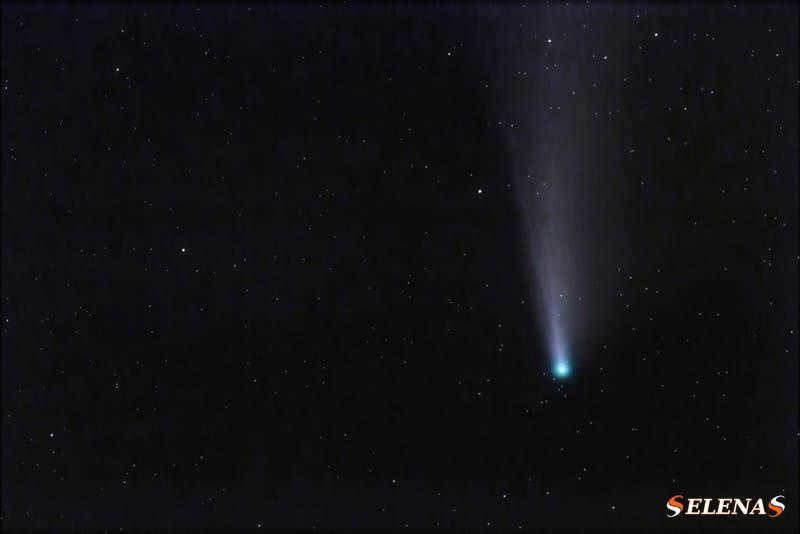
However, the small number of comets that manage to survive the challenge and reach the inner solar system, we here on Earth are usually treated to a spectacular visual display for a brief period of time.
What are the primary components of a comet?
Each comet consists of a solid, frozen core known as a nucleus.
This mass of ice and dust typically measures less than 10 miles (16 kilometers) in diameter, which is approximately the size of a small town.
However, in April 2022, astronomers captured images of a comet nucleus that was just under 80 miles in diameter using the Hubble Space Telescope – the largest ever observed.
According to scientists, comets located in the Kuiper Belt or Oort Cloud are essentially nothing more than frozen nuclei.
Nevertheless, as a comet approaches the Sun, it begins to heat up.
This phenomenon can also result in the expulsion of gas jets from the comet, which in turn expels dust particles.
The gases and dust particles that escape form a coma that surrounds the nucleus of the comet.
Due to a similar mechanism, this process also leads to the formation of tails in comets.
The striking, curved tail that extends for millions of miles behind the comet is created as dust and gases are pushed away from the comet’s nucleus by the pressure exerted by solar radiation.
More recently, astronomers have made the discovery that comets actually possess two distinct tails upon closer examination.
One of these tails is composed of dust and appears white or yellow in color.
This dust tail follows the comet’s trajectory in a wide, gently curving arc.
The other tail, known as an ion tail, has a bluish hue and consists of ions or gas molecules that possess an electrical charge.
These tails always point away from the Sun.
Have we ever explored a comet?
For thousands of years, humans have been fascinated by comets, and some comets have been making regular appearances for centuries.
Even though comets are visually captivating, it can be challenging to actually observe the nucleus of each comet because it is hidden by the gas and dust coma that surrounds it.
This has hindered our complete comprehension of the characteristics of comets.
Nevertheless, in recent times, several spacecraft have been given the chance to extensively investigate comets.
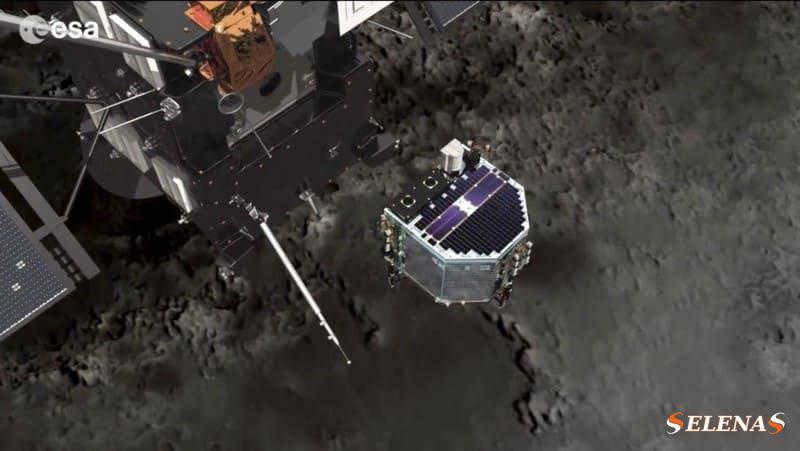
As a matter of fact, the samples of comet Wild 2, also known as “Vilt Two,” were collected by NASA’s Stardust mission and brought back to Earth.
It was discovered by scientists that these particles contain an abundance of hydrocarbons, which are considered the fundamental components of life.
The Rosetta mission, led by the European Space Agency and involving various NASA instruments, successfully conducted a comprehensive study on comet 67P Churyumov-Gerasimenko.
Following the deployment of the Philae landing module onto the comet’s nucleus, Rosetta spent two years in orbit around the comet, transmitting data from Philae.
The photographs also revealed that comet “67P Churyumov-Gerasimenko” is a solid object with active surface activity.
Rosetta/Philae also discovered complex compounds on the comet that could potentially serve as fundamental building blocks for life.
What information do you possess regarding comets?
- Comets follow elliptical paths around the Sun, similar to planets. However, the orbit of a comet is significantly more elliptical than that of any planet.

- Comets are believed to originate in one of two areas, either the Oort Cloud or the Kuiper Belt, which are located beyond the orbit of Neptune.
- A comet consists of four parts: a nucleus, a coma, a dust tail, and an ion tail.
- The majority of a comet’s total mass is contained in its nucleus.
- A comet’s tail is formed by the solar wind, which carries gas particles directly away from the Sun.
- As comets approach the Sun, they develop a halo. This halo is created when the ice and gas in the comet are vaporized by solar radiation, forming a coma around it.
- The dust tail of a comet is a trail of dust and rocky material that remains behind as the comet orbits.

- The Oort cloud is a distant region of the solar system, estimated to be 50,000 to 150,000 times the distance from the Sun to Earth. It is thought to contain a vast number of inactive comets. Some of these comets have orbital periods lasting millions of years.
- The Kuiper Belt is a belt of inactive comets located just beyond Neptune’s orbit. Comets originating from this region have orbital periods lasting hundreds of years or less.
- One of the most well-known comets is Halley’s Comet. It has been observed since at least 240 BC and is visible from Earth every 76 years due to its orbit. It was named after the British astronomer Edmond Halley.
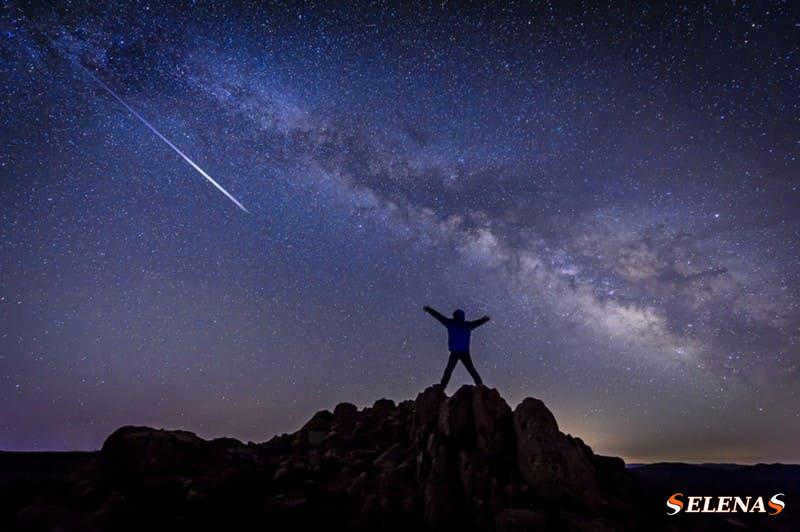

- There are currently over 3,000 identified comets. Scientists estimate that there could be as many as one billion comets in our solar system.
- A large comet is a comet that is bright enough to be visible from Earth without the use of a telescope. Approximately one large comet passes by every ten years.
- While most comets are relatively small, with average diameters ranging from 2,460 feet (750 meters) or less to about 12 miles (20 kilometers), there have been discoveries of much larger ones. One notable example is “UN271,” which measures about 75 miles (120 kilometers) in diameter.
What are some of the most well-known comets?
There are numerous renowned comets, with some having been recognized by ancient civilizations and others only recently discovered.
Here are a few of the most famous comets:
One of the most well-known is Halley’s Comet, which can be viewed without the aid of a telescope.
While it has been observed since ancient times, including in 1531, 1607, and 1682, it was Edmond Halley who proposed that it was actually the same comet.
In 1705, he conducted a study on the orbits of various known comets and compared his findings with historical comet records.
Halley quickly deduced that a specific comet must be the same one observed multiple times in previous centuries.
As a tribute to Halley’s findings, the comet was named after him.
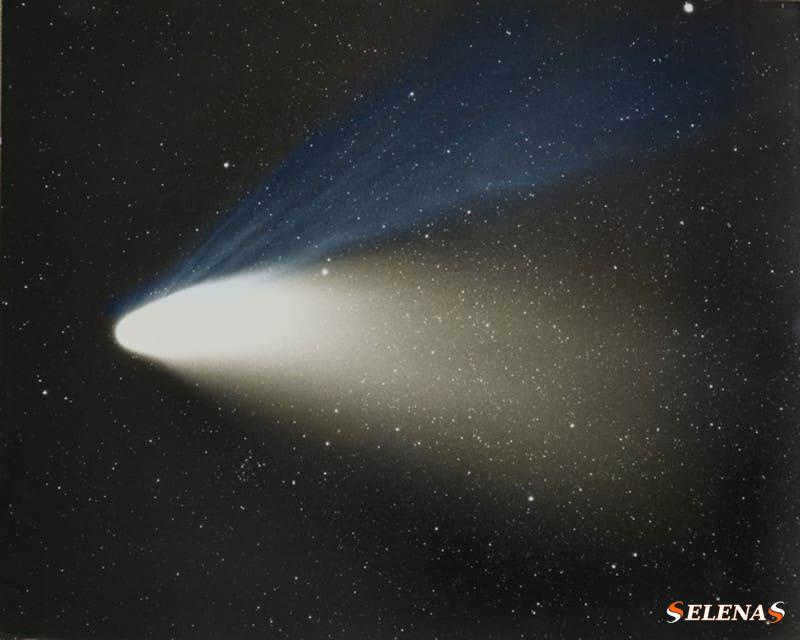
Close by is the Hale-Bopp comet (Hale-Bopp).
The Hale-Bopp comet was also visible to the naked eye and is perhaps most well-known for the highly publicized Heaven’s Gate cult, which believed that an advanced alien being was God and was traveling in a spaceship following the trail of the Hale-Bopp comet.
The Hale-Bopp comet was last observed in 1997 and will not be seen again for approximately 2,300 years.
It is named after its discoverers, Alan Hale and Thomas Bopp.
Another famous, although no longer active, comet is Shoemaker-Levy 9.
Shoemaker-Levy 9, also referred to as “SL 9”, consisted of a series of active cometary nuclei that were captured by Jupiter’s gravitational pull and subsequently began orbiting the planet.
The name Shoemaker-Levy 9 was given to this celestial body in honor of its discoverers, Gene Shoemaker, Carolyn Shoemaker, and David Levy.
What exactly is an asteroid?
In simple terms, asteroids are small rocky objects that revolve around the Sun and are not large enough to be classified as planets.
There are numerous asteroids within our solar system, with over 1 million currently known. Most of them are found in the primary asteroid belt, which is located between the orbits of Mars and Jupiter.
However, asteroids are not limited to just this belt.
For instance, some asteroids, known as Trojans, share the same orbit as a planet.
These Trojans do not collide with the planet because they are positioned at Lagrange points, where the gravitational forces from the Sun and the planet are in equilibrium.
Jupiter is associated with a significant number of Trojan asteroids.
What is the origin of asteroids?
Astronomers generally posit that asteroids are the residual remnants of the formation process of our solar system.
This event occurred approximately 4.6 billion years ago, when a vast cloud of gas and dust underwent a collapse inward.
During this collapse, the majority of the substances gravitated towards the center of the cloud and gave rise to the formation of the Sun.
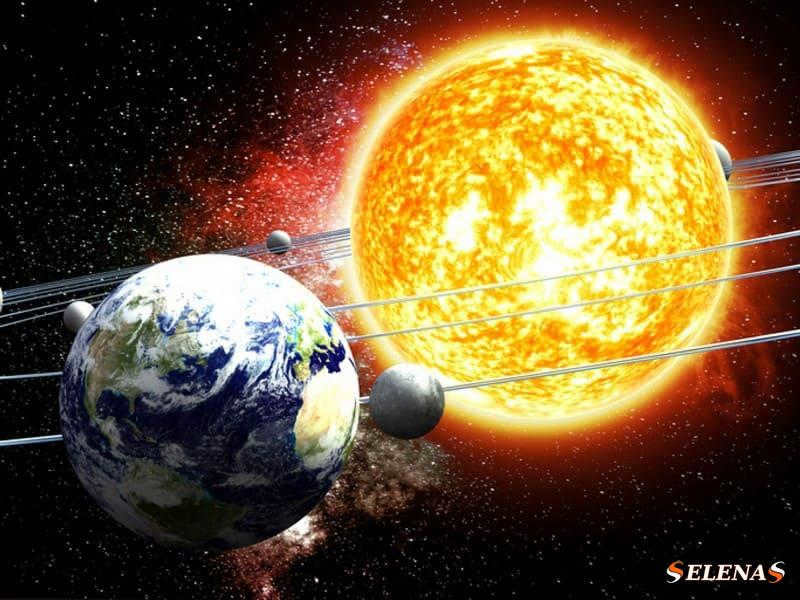
The remaining material in that cloud also started to condense and shape into planets.
Those fragments of material that currently make up the asteroid belt apparently never had the opportunity to fully develop into a single planet or multiple planets.
Similar to planets, this process of formation was not consistent throughout the solar system, resulting in asteroids of various sizes (and forms).
Due to this, no two asteroids are identical, as they formed in different locations at different distances from the Sun.
However, they do tend to share certain common characteristics:
- Unlike planets, asteroids usually do not have a round shape. Instead, their shape is often irregular and jagged;
- Many asteroids are smaller than pebbles, but some can reach hundreds of miles/kilometers in diameter;
- Many asteroids are made up of different kinds of clay and silicate rocks, but there are also some that contain metals like nickel and iron.
What can we discover from asteroids?
Asteroids provide valuable information to scientists about the development of the planets and the Sun as they were formed during the same period as our solar system.
Scientists can gain further knowledge about asteroids by examining meteorites, which are small fragments of asteroids that have passed through Earth’s atmosphere and landed on its surface.
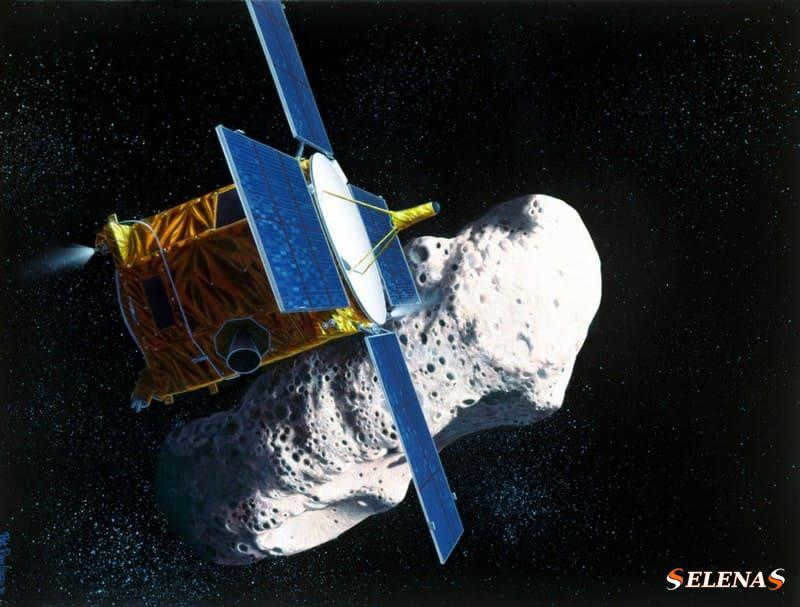

An artist’s depiction of the NEAR spacecraft from NASA as it lands on the Eros asteroid.
We can also observe and examine these celestial bodies when they come near to Earth.
As an example, the NEAR Shoemaker probe successfully reached and touched down on the Eros asteroid, which is in close proximity to our planet.
In 2011, the Dawn probe ventured into the asteroid belt.
It conducted observations and completed orbits around the dwarf planet Ceres and the massive Vesta asteroid.
NASA launched the OSIRIS-REx probe in 2016 in order to investigate the “Bennu” asteroid, which is located nearby Earth.
The spacecraft arrived at Bennu in 2018 and is set to bring back a collection of pebbles and dust from the asteroid’s surface to Earth by 2023.
In September 2023, the OSIRIS-REx sample container will touch down in the Utah desert.
In order to gain further insight into planetary evolution and the origins of life, researchers will extract the contents of the container and examine the minerals and dust it contains.
We have discussed numerous subjects, such as outer space, previously. However, if you desire additional knowledge on the topic of asteroids, here are a handful of intriguing facts.
1. There exists a vast number of asteroids, potentially in the millions or even more
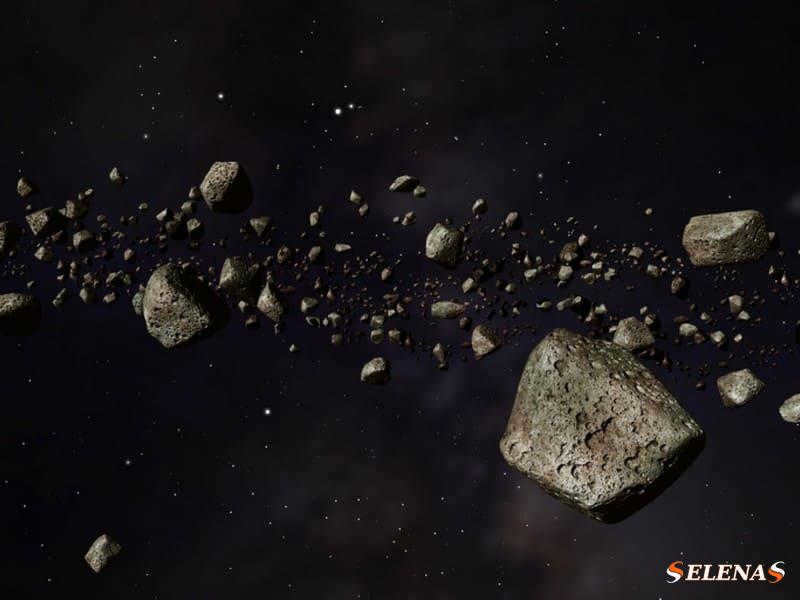
There is a vast number of asteroids in our solar system alone.
Scientists have not yet managed to count each individual one, but they definitely amount to millions, and perhaps even billions.
A significant quantity of them can be found in the asteroid belt.
Interestingly, their presence in this region is heavily influenced by Jupiter.
When this massive planet formed, countless space rocks leftover from the creation of the solar system became trapped in Jupiter’s powerful gravitational pull.
This is believed to be the primary factor that prevented the formation of additional planets between Mars and Jupiter.
These countless asteroids, which come in a wide range of sizes, orbit the Sun along broad elliptical paths.
2. Certain asteroids could possess their own miniature moons and bands


Asteroids possess a weak gravitational pull due to their relatively small size in comparison to celestial bodies like planets.
However, when a smaller rock comes into close proximity with a larger one, the larger rock exerts its gravitational force on the smaller one, potentially transforming it into a miniature moon.
In 2013, scientists made the groundbreaking discovery that an asteroid could potentially possess rings similar to those found around planets.
While these rings may lack the size and grandeur of, for instance, Saturn’s rings, they essentially represent the same phenomenon albeit on a smaller scale.
Under specific circumstances, the merging of two or more diminutive asteroids can also result in the formation of a tail-like extension of an asteroid.
3. Certain asteroids have transformed into satellites
Occasionally, asteroids traverse, collide with, or collide into planets while they revolve around the Sun.
Several of these asteroids experience the pull of the planet’s gravitational force and have the potential to be permanently ensnared within a small moon.
This process is believed to be the mechanism by which certain moons of Mars, Jupiter, Saturn, Uranus, and Neptune came into existence.
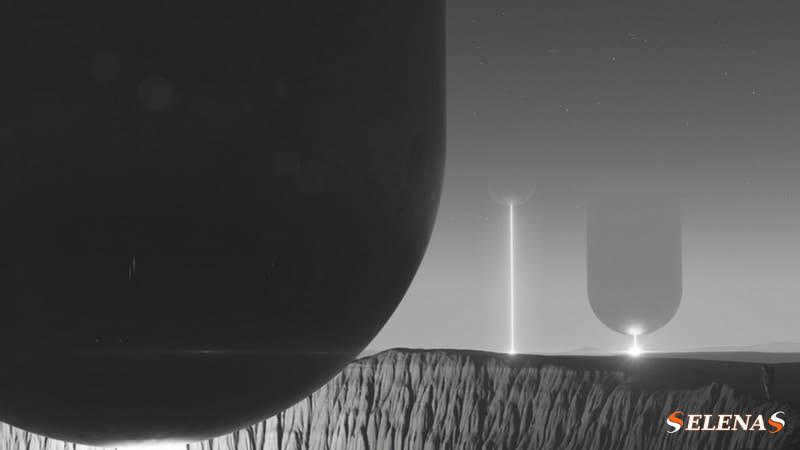
Asteroids contain a variety of valuable substances, such as metals, silica, and carbon.
Additionally, some asteroids may even contain water ice within their debris.
Scientists believe that these essential elements may have been transported to planets during the early stages of the solar system, when asteroids collided with them.
Furthermore, they argue that asteroid deposits could have played a crucial role in the emergence of life on Earth.
To better understand and exploit these mineral resources, researchers are actively seeking ways to study asteroids more extensively.
Currently, this mainly involves sending probes, but it is possible that in the future, we could utilize asteroids as a valuable resource hub in space.
5. It is common for asteroids to have peculiar shapes
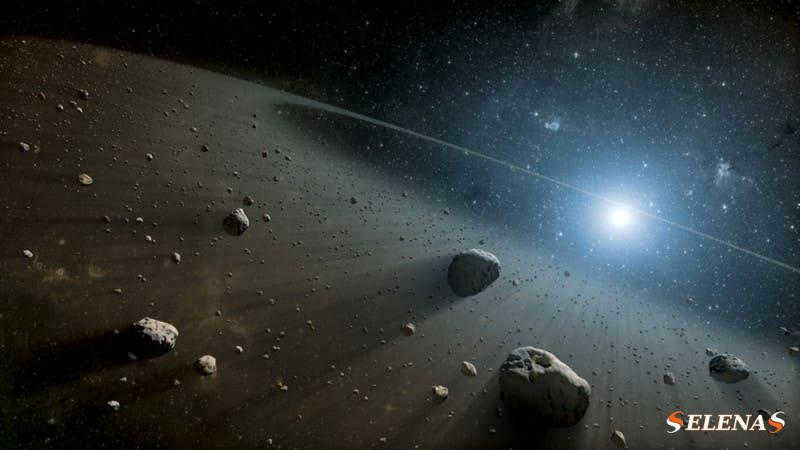
Asteroids come in a variety of sizes, ranging from the massive Vesta, which measures 329 miles (530 kilometers) in diameter, to small ones that are less than 33 feet (10 meters) across.
Additionally, their rocky composition and weak gravitational pull give them irregular shapes.
Furthermore, most asteroids are covered in layers of dust.
These space rocks have an average surface temperature of approximately -70 degrees Celsius and lack the ability to hold an atmosphere.
6. Certain asteroids possess distinct formations called gullies
In 2015, scientists made a remarkable discovery on the asteroid Vesta – the presence of water tracks known as gullies.
Gullies are formed when a smaller asteroid collides with a larger one, causing the trapped water ice to melt and create these unique formations.
What sets comets apart from asteroids?
In essence, comets are icy conglomerates that typically originate from the Oort Cloud, whereas asteroids are predominantly rocky bodies that typically originate from the asteroid belt.
Nevertheless, there are instances where the distinction between the two can become blurred, leading to some overlaps.

In any event, both are minuscule entities revolving around the Sun, and both came into existence relatively recently (approximately 4.5 billion years ago).
Nevertheless, the manner in which they were formed differed enough to render them distinct entities.
Allow us to examine the key distinctions.
1- Asteroids typically consist of rocky matter from the asteroid belt.
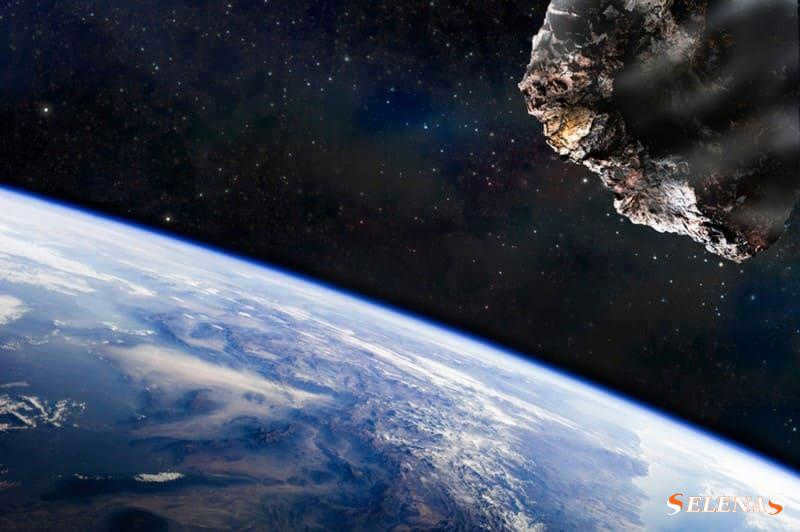

Asteroids, in general, are typically small celestial bodies that remain from the formation of the solar system.
They commonly consist of rocks and can vary in size, containing a mixture of metals, clay, and stony materials similar to those found on Earth.
Furthermore, they often exhibit an irregular and bumpy surface, which some individuals liken to the shape of a potato.
2. Conversely, comets have the potential to originate from the Oort Cloud and possess a composition rich in ice.
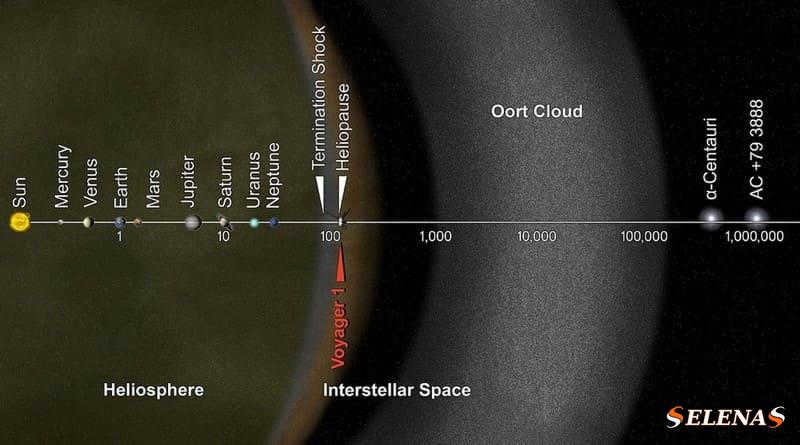
Unlike asteroids, comets often originate from the Oort Cloud, which is located far beyond Pluto’s orbit within the solar system.
Comets have much longer orbits compared to asteroids, sometimes extending into the most distant regions of the solar system, where they can be affected by neighboring stars.
If this occurs, the comet can then plunge inward towards the Sun.
Comets are icier than asteroids because they form in the extremely cold outer regions of the solar system.
They are often referred to as “dirty snowballs” due to their composition of rock and ice.
As comets approach the Sun, they develop their characteristic gas and dust tails.
The International Astronomical Union (IAU) is responsible for the task of assigning names to asteroids, according to NASA. The naming process for asteroids is relatively flexible and allows for a range of choices. As a result, asteroids can be named after individuals, musicians, or fictional characters from television and movies, such as “3505 Byrd,” “8749 Beatles,” or “Mr. Spock.” However, there are also more serious names given to certain asteroids, such as the seven asteroids that have been named after the crew of the space shuttle Columbia, who tragically lost their lives in 2003.
4. Comets typically possess tails, while asteroids typically do not
Comets generally exhibit one or both varieties of tails.
When a comet approaches the Sun at a distance closer than the orbit of Mars, it typically develops a gas tail.
The other type of tail, known as the dust tail, consists of minuscule solid dust particles.
5. However, it can pose a challenge to differentiate between the two
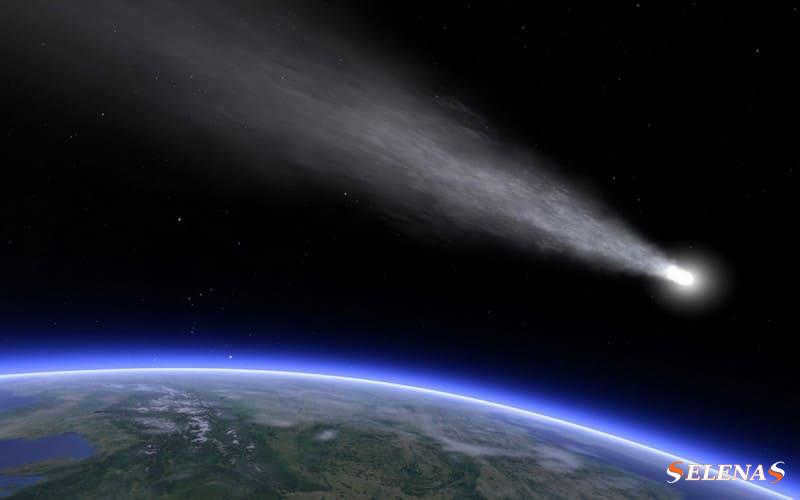
Not all asteroids and comets precisely fulfill the fundamental requirements mentioned above.
Other comets can be found with orbits that are much closer to the Sun compared to those originating from the Oort Cloud.
Comets known as “short-period comets” refer to comets with orbital periods of less than 200 years.
The majority of short-period comets orbit the planets in the same direction.
Halley’s Comet, the most renowned comet of all, is one notable exception to this pattern.
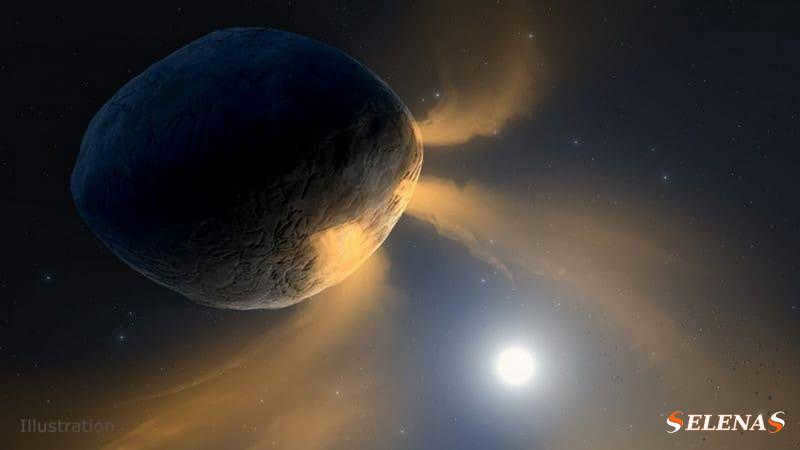
The distinction between the two can become even more complex in certain situations.
For instance, comets typically act as parent bodies for yearly meteor streams.
Comets are delicate entities that often leave behind a trail of icy debris as they approach the Sun.
Each year, the Earth passes through various trails of such old comets.
We witness meteor showers because the debris from comets enters our atmosphere and burns up.
For example, the Orionids and Eta Aquariidae meteor streams are formed from the debris of Halley’s Comet.
The Leonids meteor shower originates from the comet Tempel-Tuttle.
However, not all meteor showers are caused by comets.
A mysterious object called “3200 Phaeton” is the source of the Geminid meteor shower, which is observed every December.
This particular object, sometimes known as a “rock comet,” bears a resemblance to a combination of an asteroid and a comet in various aspects.
7. There exist even hybrids of asteroids and comets
Due to entities like “3200 Phaethon,” the line between asteroids and comets is muddled by a multitude of objects.
Images of the asteroid “311P/PANSTARRS” captured by the Hubble Space Telescope unveiled not just one, but six tails!
Aside from functioning as a main belt comet, this peculiar asteroid conceivably possesses a satellite in its vicinity.
Indeed, space is an exceedingly strange realm.
And for today, these enthusiasts of comets and asteroids are your go-to source.
To summarize, the primary distinction between comets and asteroids lies in their composition, place of origin, orbits, and morphology.
Most asteroids are solid bodies located within the asteroid belt, while comets consist of a mixture of ice and dust and can originate from the Oort Cloud.
However, in recent times, the clear distinction between these two types of celestial objects has become increasingly blurred.
It is uncertain how many more hybrid comet-asteroids will be discovered in the future.
If you have any further inquiries or would like to leave a comment regarding this article, please feel free to do so in the comments section below.
Take care and see you soon!
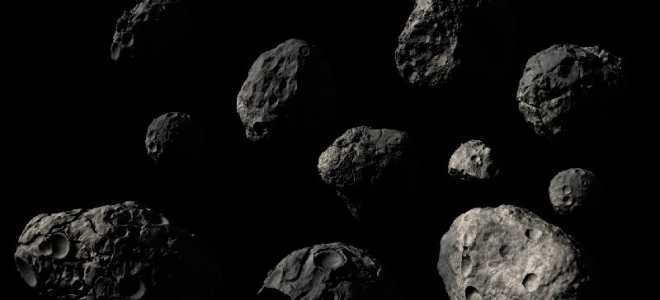
It is common knowledge that the celestial bodies known as asteroids and comets orbit the Sun. However, it is important to note that they should not be mistaken for one another. These two entities are distinct objects that not only differ from each other, but also belong to different groups.
Today, we will delve into some fascinating facts about comets and asteroids, as well as explore their primary distinctions.
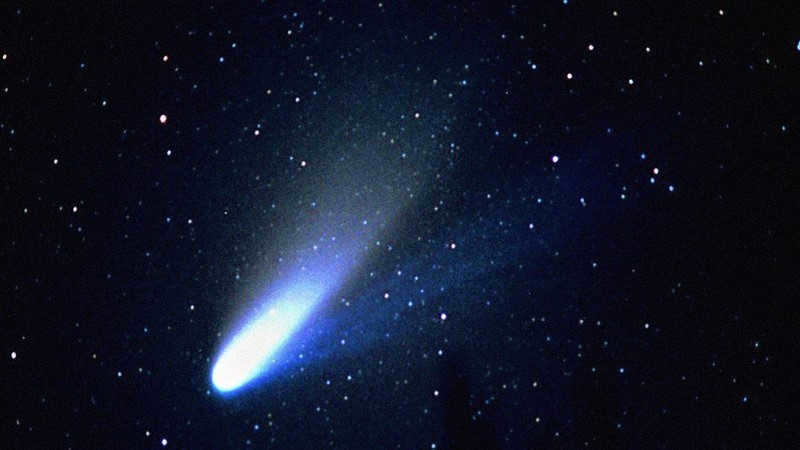
What distinguishes a comet from an asteroid?
Primarily, the distinction between a comet and an asteroid lies in their composition. In fact, asteroids are comprised of rocky materials, whereas comets are predominantly composed of ice (hence their designation as “icy”).
Another significant disparity that sets comets apart from asteroids is the relatively unchanging state of their substance. It is postulated that these celestial objects were formed during the early stages of the solar system’s development. Since then, they have remained frozen, virtually unaltered. It is likely that our entire star system originated from the same elemental matter.
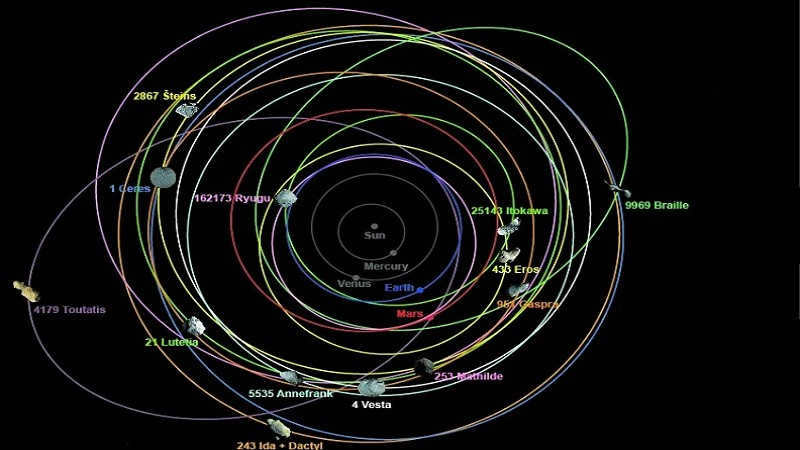
Typically, a cometary entity is a linked cluster of particles consisting of dust, ice, and rock. Its core is porous, relatively small, and primarily made up of frozen water and carbon dioxide.
On the other hand, asteroidal entities are rocky in nature and contain a mixture of metals, which makes them a prime target for mining precious elements.
How Asteroids and Comets Move
Moreover, the orbital characteristics of asteroids and comets distinguish them. Put differently, they exhibit distinct orbital shapes, which determine their movement patterns.
While both objects revolve around our central star, their trajectories differ. This discrepancy primarily stems from their varying distances from the Sun.
Given that a considerable number of asteroids cluster in the primary belt positioned between the orbits of Mars and Jupiter, they possess orbits that are nearly circular.

However, comets typically have elliptical orbits that are highly elongated and wide. Some comets only pass near the Sun once and then travel very far away from it. It is likely that they will eventually return to the Sun due to gravitational forces. These comets are known as long-period objects and are mostly found in the Oort cloud, which is located on the outskirts of the solar system.
On the other hand, there are comets with short-periodic orbits that frequently come close to the Sun. When they approach the Sun, their matter is subjected to high temperatures and undergoes some changes. For instance, the heat can cause the ice in the nucleus to melt, forming a gas-dust cloud called a coma.
It is fascinating that the length of comet tails can reach tens of millions of kilometers. On certain occasions, they can even be observed without the aid of telescopes.
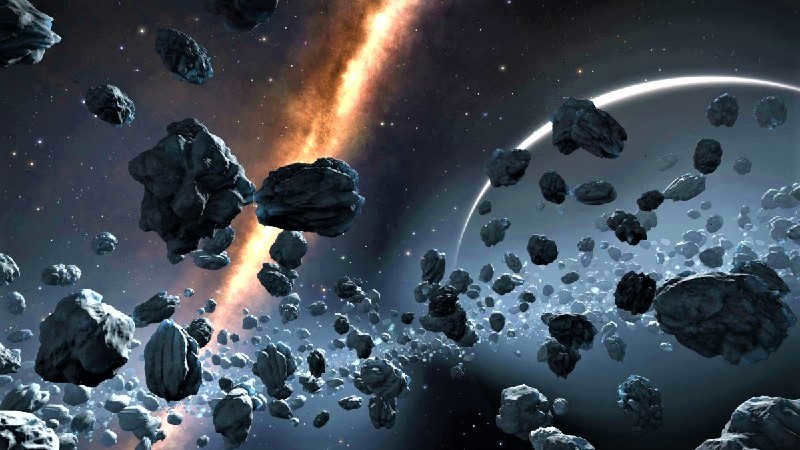
Which celestial object do you believe is larger – a comet or an asteroid?
As per the findings of astronomers, cometary bodies typically have a diameter of approximately 3 km or larger, whereas asteroids can range in size from a few meters to the size of Earth’s continents. Hence, the latter are considerably larger in size compared to their icy counterparts.
Scientists believe that asteroids and comets are the remnants of the matter that gave birth to our solar system. Asteroids, being closer to the sun, are composed of stone and metal. On the other hand, comets were formed in more distant regions and are characterized by their icy composition.
When it comes to the relationship between comets, meteors, and asteroids, we can establish the following chain:
- Asteroids and comets emerged during the early stages of the solar system’s formation;
- As they journey through space, they have the potential to intersect with other celestial bodies, including Earth’s orbit;
- Due to their large numbers and collisions, comets and asteroids collapse and form fragments. These fragments become meteorites when they fall on the Earth’s surface.
It is evident that there is a certain sequence of events. In reality, there was originally a single substance that shaped everything around us.
Therefore, we have gained knowledge about comets and asteroids, their distinguishing features, and their movement in outer space. Naturally, there is still much we do not know, but observing them is crucial.
In truth, all celestial bodies are of immense interest to scientists. By studying and exploring them, we enhance our understanding of the Universe. Additionally, the potential for space bodies colliding with Earth cannot be disregarded. Hence, we must determine the likelihood, consequences, and take necessary measures to protect ourselves from this threat to the best of our abilities.
Every year, the media reports on a new danger from space – a massive asteroid, a lethal comet, or a catastrophic meteor shower that could potentially strike our planet at any given moment. However, the average individual often has limited knowledge about these celestial objects.

Indeed, the categorization of these celestial objects is relatively straightforward, although astronomers lack precise criteria for definitively assigning a celestial body to a specific category.
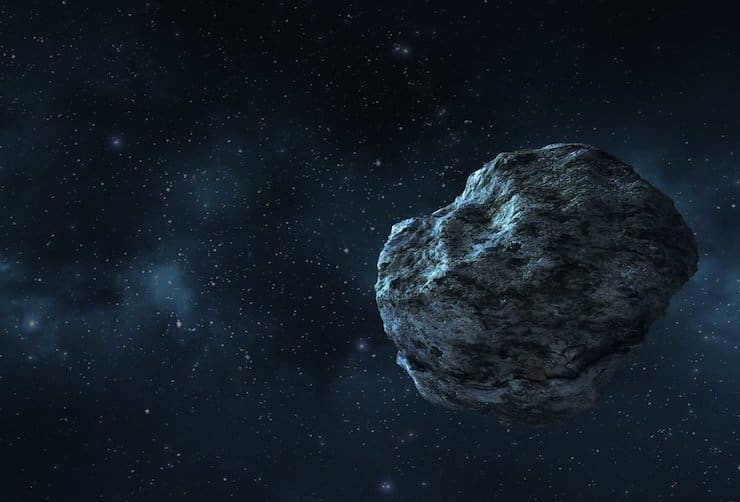
A meteoroid is a compact, irregularly shaped object made of rock, metal, or other solid materials that orbits in space or becomes displaced from its original trajectory due to interactions with other celestial bodies, such as colliding with another meteoroid.
To put it simply, meteoroids are small rocks or metal fragments, typically measuring up to 30 meters across (this is an approximate estimate), that traverse through the vast expanse of space.
Asteroid
can be paraphrased as
Space rock
.
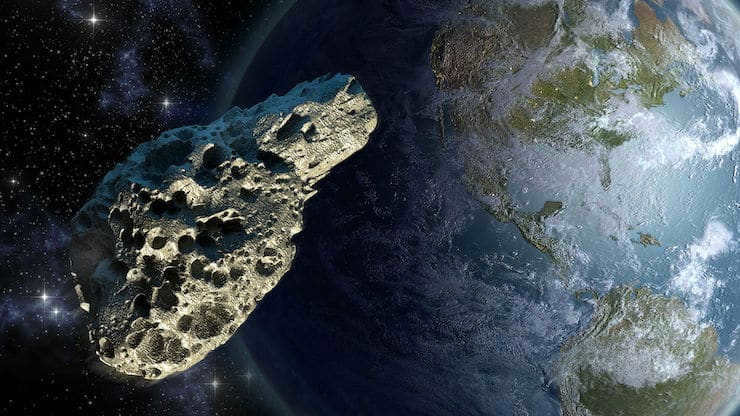
The primary distinction between an asteroid and a meteoroid lies in their size, with asteroids reaching the dimensions of a dwarf planet. Numerous asteroids possess such a significant mass that they attain a spherical shape and may even exhibit signs of an atmosphere due to their own gravitational pull.
A prominent example is Ceres, which boasts a diameter of nearly 1000 kilometers. If it were able to clear its orbit of other celestial bodies, it would be classified as a full-fledged planet.
However, Ceres is situated within the asteroid belt, where a vast array of objects can be found. This includes “pebbles” such as Vesta and Pallada, each with a diameter of around half a thousand kilometers.
Simply put, an asteroid is a meteoroid that is larger than 30 meters in diameter.
Comet
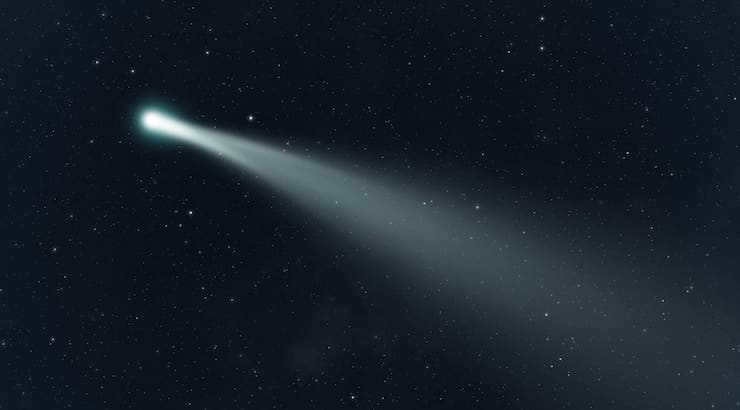
The solar system is home to snow lines, which are areas beyond the asteroid belt and extending all the way to the orbit of Neptune. These snow lines mark the point at which various compounds, such as water and carbon dioxide, transition from a gaseous state to a solid state. It is within these regions that comets take shape.
At its core, a comet is essentially a meteoroid, similar to a typical rock or metal object. The key distinction lies in the fact that comets are composed primarily of ice.
Just like meteoroids, these blocks of ice also deviate from their orbit due to interactions with other celestial bodies and head towards the center of the solar system. Once here, they await their inevitable partial destruction under the influence of a star, creating that beautiful “tail” and transforming the icy meteoroid into a comet.
According to modern astronomy, most long-period comets, many of which are observed from Earth, are believed to originate from the Oort cloud. The estimated width of the Oort cloud is up to 75 astronomical units (1 a.u. = 149,597,870 km).
In 2004, the Rosetta spacecraft was launched, which approached the comet Churyumov-Gerasimenko. Now, everyone has the opportunity to see this object from various angles through the photographs captured by the spacecraft.
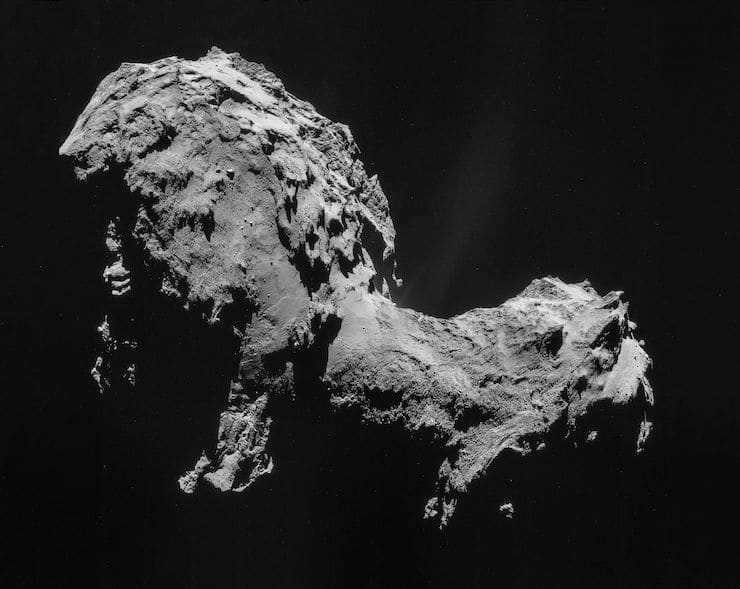
The Churyumov-Gerasimenko comet
In basic terms, a comet is a frosty meteoroid with a tail of fragments, dust, and gas created as a result of the heat effects of a star.
Meteor and bolide
A meteor is a small celestial body that enters the Earth’s atmosphere and burns up due to the friction caused by the air. It is also commonly known as a shooting star. A bolide, on the other hand, is a type of meteor that explodes in a bright flash of light and often produces a loud sound as it disintegrates in the atmosphere. While both meteor and bolide are caused by the same phenomenon of a celestial body entering the Earth’s atmosphere, the main difference lies in the intensity of the event. A bolide is a more dramatic and spectacular event compared to a regular meteor.

When a space object (such as a meteoroid, comet fragment, or asteroid) enters the solid layers of the atmosphere, it experiences friction, causing it to heat up to temperatures as high as one and a half thousand degrees Celsius.
As people observe the process of a meteor burning in the atmosphere, they often refer to it as a “falling star” and make a wish.
Meteors that burn particularly brightly and intensely are known as bolides. It is interesting to note that the flight of a bolide can be accompanied by powerful explosions. This phenomenon may help explain the event known as the “Tunguska meteorite,” which occurred in 1908 in the Yenisei province of Russia. Despite causing extensive damage to a 2000 square kilometer area of forest, the meteorite left no visible trace on the ground.
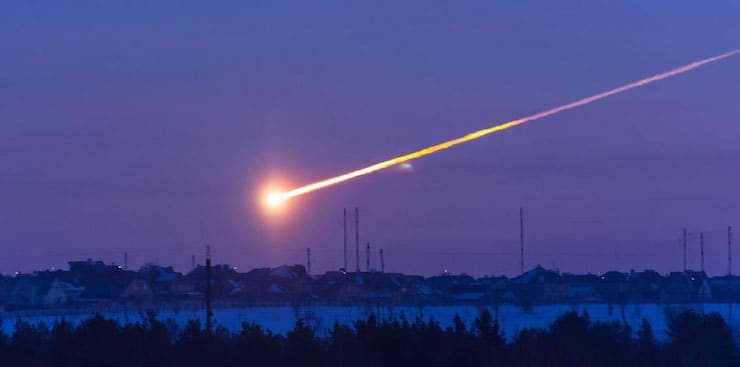
To put it simply, a meteor refers to a celestial object (meteoroid, asteroid, comet) that rapidly enters the atmosphere of a planet.
Meteorite

A meteorite, also known as a celestial body or its fragments that have made contact with a planet’s surface, is commonly referred to as a space rock. One notable example is the Chelyabinsk meteorite, which descended upon the Urals in 2013 and shattered into numerous pieces, many of which were retrieved from the depths of Lake Chebarkul. The largest fragments are now on display at the Historical Museum of the Southern Urals, serving as a testament to the impact of these extraterrestrial rocks.
Among the most renowned meteorites worldwide is the Goba meteorite, located in Namibia. Comprising a massive metal object weighing 66 tons and measuring nine cubic meters in volume, it stands as an impressive testament to the power and mystery of the cosmos.

Simply put, a meteorite is an object from space that survives the Earth’s atmosphere and lands on its surface.
How valuable is this article?
Give it a star rating!
Average rating 5 / 5. Number of ratings: 7
No ratings yet. Be the first to rate.
The universe is filled with unresolved mysteries and intriguing phenomena, and asteroids are certainly among them. The website space.com has provided an explanation of what asteroids are, their composition, and the likelihood of a massive asteroid colliding with Earth.
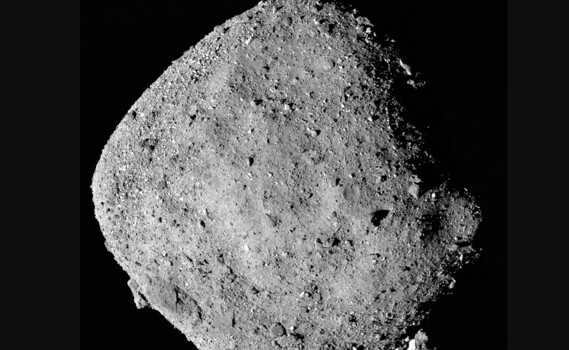
Understanding Asteroids
Asteroids are remnants of rocky materials that have existed since the formation of our solar system and its planets approximately 4.6 billion years ago. According to NASA, the majority of asteroids originate from the main asteroid belt, which is situated between Mars and Jupiter. NASA estimates that the total number of asteroids surpasses 1 million.
In the past, asteroids were referred to as “small planets” due to their potential to reach a diameter of around 500 kilometers and occasionally possess their own satellites. Additionally, asteroids can take on various shapes and forms.
As per NASA’s description, an asteroid is defined as “a relatively small, inert, rocky entity that orbits around the sun,” whereas a comet is described as “a relatively small, occasionally active entity that undergoes vaporization of its ices in the presence of sunlight, creating a gas and dust atmosphere, as well as (occasionally) a tail.”
Meteorites, on the other hand, are classified as “meteoroids that have experienced entry into the Earth’s atmosphere and have landed on the planet’s surface.” Lastly, meteors are referred to as “optical phenomena that occur as a result of the ignition of a meteoroid when it enters the Earth’s atmosphere.”
Composition of Asteroids
Asteroids can be categorized into three main groups based on their composition. Class C, also known as carbon asteroids, mainly consist of clay and silicon. Class S, or rock asteroids, are composed of silicates and nickel-iron. Lastly, Class M, or iron asteroids, are primarily made up of nickel-iron.
Furthermore, asteroids exhibit variations in density. Some asteroids are solid and dense, resembling compact objects. On the other hand, there are asteroids that resemble drifting piles of material, comprised of numerous small objects held together by the force of gravity.
Frequency of Asteroid Impacts on Earth
It is not uncommon for asteroids to collide with Earth, although the frequency and size of these impacts vary. Larger asteroids, capable of causing significant damage, collide with our planet approximately once every century. On the other hand, smaller objects, resembling a table in size, fall from the sky approximately once a month. However, these smaller asteroids typically burn up in the atmosphere, resulting in bright flames that are visible to observers on the ground. Interestingly, the frequency of asteroid impacts decreases as their size increases.
According to NASA, our planet receives an estimated 100 tons of material from space each year. While asteroids are a part of this material, they only account for a small fraction of the total amount. In fact, the early solar system experienced a much higher frequency of asteroid impacts, particularly between 7.8 million and 11.7 million years ago when conditions were more chaotic. Scientists speculate that the bombardment of Earth by asteroids during this period may have played a crucial role in the origin of life. It is believed that these impacts helped distribute water across the Earth’s surface, setting the stage for the development of life as we know it.





